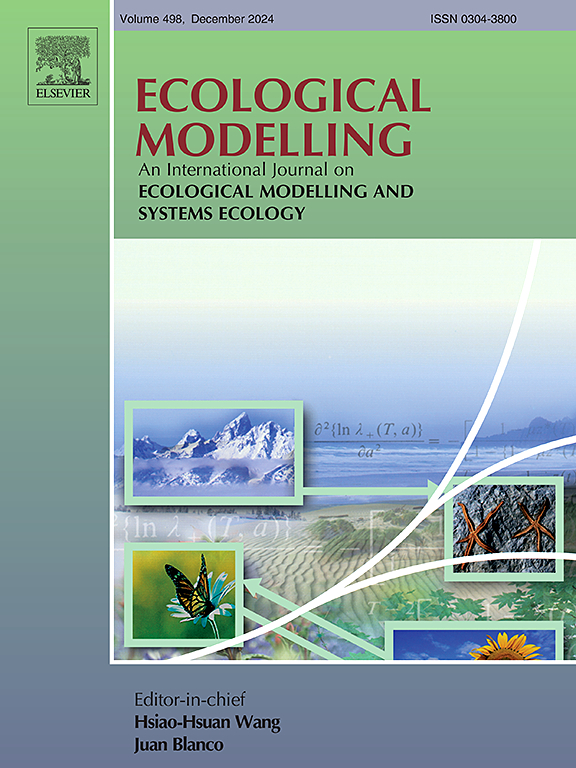What grows, adapts and lives in the digital sphere? Systematic literature review on the dynamic modelling of flora and fauna in digital twins
IF 2.6
3区 环境科学与生态学
Q2 ECOLOGY
引用次数: 0
Abstract
The modelling of flora and fauna is vital for understanding and digitally representing our environment, yet their dynamic modelling in digital twins lags behind human-made inventions like manufacturing and the built environment. The interdisciplinary nature of this research complicates tracking advancements, and no comprehensive overview exists. This Systematic Literature Review (SLR), using the PRISMA method, addresses this gap by analysing studies on dynamic modelling of flora and fauna in digital twins and 3D city models. It covers descriptive metrics and qualitative aspects, identifying key research fields, directions, users, and developers. Additionally, this SLR details on digital twin data, modelling techniques, actuators, user experience with human-computer interaction, and ethical considerations. The findings highlight that the digital twin concept is being increasingly applied to the dynamical modelling of flora and fauna. Moreover, the broad relevance of this research is demonstrated across various fields including ecology, forestry, urban studies, and agriculture, where diverse methods and technologies are used, though progress remains uneven. Currently, precision agriculture is leading the way in automated, bidirectional synchronisation between digital twins and their physical counterparts. Complementing traditional modelling techniques with AI and machine learning where appropriate, expands modelling capabilities. Meanwhile, multimodal interfaces enhance the immersive user experience. Despite these advances, challenges persist in data availability, foundational knowledge, complex interaction modelling, standardisation and transferability, underscoring the need for continued research. Digital twins for the biotic environment show promise in supporting United Nations Sustainable Development Goals 2, 11, 13, 14, and 15. This overview supports researchers and practitioners in developing digital twin applications which include flora and fauna.

是什么在数字领域生长、适应和生存?对数字双胞胎中动植物群动态建模的系统文献综述
动植物的建模对于理解和数字化表示我们的环境至关重要,但它们在数字双胞胎中的动态建模落后于制造业和建筑环境等人为发明。这项研究的跨学科性质使跟踪进展变得复杂,并且没有全面的概述。本系统文献综述(SLR)使用PRISMA方法,通过分析数字双胞胎和3D城市模型中动植物动态建模的研究,解决了这一差距。它涵盖了描述性度量和定性方面,确定了关键的研究领域、方向、用户和开发人员。此外,该单反详细介绍了数字孪生数据、建模技术、执行器、人机交互的用户体验和道德考虑。研究结果强调,数字孪生概念正越来越多地应用于动植物的动态建模。此外,这项研究的广泛相关性在各个领域得到了证明,包括生态学、林业、城市研究和农业,这些领域使用了不同的方法和技术,尽管进展仍然不平衡。目前,精准农业在数字孪生体和物理孪生体之间的自动化、双向同步方面处于领先地位。在适当的地方用人工智能和机器学习补充传统的建模技术,扩展建模能力。同时,多模式界面增强了沉浸式用户体验。尽管取得了这些进展,但在数据可用性、基础知识、复杂的相互作用建模、标准化和可转移性方面仍然存在挑战,强调了继续研究的必要性。生物环境的数字双胞胎有望支持联合国可持续发展目标2、11、13、14和15。这个概述支持研究人员和从业者在开发数字孪生应用,包括植物和动物。
本文章由计算机程序翻译,如有差异,请以英文原文为准。
求助全文
约1分钟内获得全文
求助全文
来源期刊

Ecological Modelling
环境科学-生态学
CiteScore
5.60
自引率
6.50%
发文量
259
审稿时长
69 days
期刊介绍:
The journal is concerned with the use of mathematical models and systems analysis for the description of ecological processes and for the sustainable management of resources. Human activity and well-being are dependent on and integrated with the functioning of ecosystems and the services they provide. We aim to understand these basic ecosystem functions using mathematical and conceptual modelling, systems analysis, thermodynamics, computer simulations, and ecological theory. This leads to a preference for process-based models embedded in theory with explicit causative agents as opposed to strictly statistical or correlative descriptions. These modelling methods can be applied to a wide spectrum of issues ranging from basic ecology to human ecology to socio-ecological systems. The journal welcomes research articles, short communications, review articles, letters to the editor, book reviews, and other communications. The journal also supports the activities of the [International Society of Ecological Modelling (ISEM)](http://www.isemna.org/).
 求助内容:
求助内容: 应助结果提醒方式:
应助结果提醒方式:


